探讨免费游戏的可行收费方式及其设计影响
作者:Noel
免费游戏(游戏邦注:在本文中,作者将免费游戏与免费增值游戏归为同类讨论)在行业内的声誉比较差,近期受到众多开发者的攻击。尽管此类游戏赚取了大笔金钱,但是从游戏设计的观点和角度来看,确实有许多此类游戏的质量不佳,这是事实。
但重要的是,我们应当将盈利模型(游戏邦注:免费游戏中内置了某些供玩家花费金钱的内容)和那些早期游戏的质量及其背后的意图分开来看待。我坚信,免费游戏将占领未来游戏市场。作为游戏开发者,我们需要探索如何使用免费模式来制作出绝妙的游戏。
以下是我认为可以在免费游戏中收费的项目及其对游戏设计产生的影响:
1、减少冷却时间。这确实很有效,但稍微有点强制性的感觉。而且,这也让我想起经常问自己的一个问题:如果我移除游戏中的此类元素,会让游戏变得更好还是更差?结论就是,如果移除此类东西,总是会让游戏变得更好。
2、游戏内置货币。如果不是竞争型多人游戏的话,这似乎是个比较好的选择。但这会影响到游戏的平衡性,付费玩家或许会觉得游戏变得过于简单和无趣,非付费玩家可能会觉得通过刷任务而得到货币的过程很乏味。不过这种方法仍然可以考虑,尤其是手机游戏。人们可以选择自己想要的游戏体验。
3、额外内容。这似乎是种较为传统而且其他开发者认同的方法。PC和主机游戏出售DLC的做法已经有很长的历史。主要问题在于,需要额外内容的玩家并不多,你能够售出的内容数量有限,而且制作这些内容通常需要投入大量精力。
4、额外的选择。包括不同的角色、服饰和武器等。你购买的东西不会完全提升技能,而且也不仅局限于新关卡或任务。让玩家通过赢取游戏货币兑换这些选择(游戏邦注:如果玩家不想花钱,可以通过刷任务来赢取货币),似乎是个很不错的方法。你也可以采用《英雄联盟》的方法,让玩家限时体验额外内容,这样玩家在尝到甜头后或许会选择将其永久性地购买下来。
5、作弊。作弊的意思是拥有更多的生命和抗性等。使用这种方法似乎让游戏回到街机盛行的年代。某些玩家可能会受到这种设计的影响,但是这种方法在部分游戏中仍适用。你或许需要稍微调整下高分排行榜,比如将作弊的玩家分配到另一个排行榜上。
游戏邦注:本文发稿于2011年11月15日,所涉时间、事件和数据均以此为准。(本文为游戏邦/gamerboom.com编译,拒绝任何不保留版权的转载,如需转载请联系:游戏邦)
Designing Good Free-To-Play Games
Noel
It’s pretty clear that free-to-play games are the way to go if you care about making money from your games. And don’t give me that line about being indie and not caring about the money. On the contrary, being able to make money from the games we love to make, allows us to keep doing what we’re passionate about.
I was having a discussion today about free games with other developers and I thought I would post here some random thoughts and open it up for discussion. Free-to-play (or freemium – even if they aren’t exactly the same, I’m bundling them all under the same category for this discussion), have a fairly bad reputation, and they’ve been under fire recently from developers. It’s true that a lot of those games have been rather poor from a game design point of view, while raking in loads of money from players who are apparently happy to play them.
It’s important to separate the financial model (free with other ways for players to spend money in-game), and the quality of those early games or the intentions behind them. I am convinced that free games is the future of mass-market games (it’s already pretty much the present, so that’s not much of a stretch).
There’s no doubt that the financial model of game affects its design. Compare arcade games, retail console games, and subscription-based games just as an example. Free-to-play has a huge impact on the design as well.
Free-to-play games are in their infancy. Not only are they a relatively recent happening, but they were also wildly successful, which encouraged a lot of copying and not much innovation. So they’re stuck in a type of design that results in a local maximum of profit, while providing a not very satisfying experience for a lot of players. As game developers, we need to find out how to make great games while using the free-to-play model.
I’ve been going around this quite a bit recently, because I’m in the stages of deciding what my next game is going to be. The reality of the App Store are pushing me towards free-to-play, but I’m not interested in making a Farm/Store/Pet game.
These are my random thoughts on what we can charge for in a free game and how it affects game design:
Reduce delays. This is very effective, but feels cheap and somewhat manipulative (yes, this is coming from the guy who did Flower Garden… but that was before IAPs and the whole point of the game was the nurturing/waiting part). It also falls in the category of the question I often ask myself: If I remove this from the game, will it be better or worse? The answer is (almost) always “better” by removing those delays.
In-game currency. This is seems like a better approach as long as there’s no competitive multiplayer. However, it does wreck havoc with the game balance. Either it becomes too easy and not fun for those who paid, or boring and grindy for those who didn’t. Still, especially on mobile, it’s not a totally bad way to go. You’re letting people make a choice how they want their experience.
Extra content. That seems to be the traditional, developer-approved way to go. PC and console games have been doing that with DLCs for a long time. The main problem is that not many players want that content, the amount of content you can sell is limited, and it often requires a lot of extra effort to generate.
Extra choices. This includes different characters, clothes, weapons, etc. I see this as the sweet spot between the last two options. What you buy doesn’t completely throw off the game curve, but it’s also not just new levels or missions. Combine that with letting players earn credits to get those choices (by grinding if they want to, but it’s all optional) and it seems like a good way to go. You can also go the way of League of Legends (which I have yet to play!) and you can rotate in that extra content for limited amounts of time, so players get a taste and they have the option of buying them permanently.
Cheats. By cheats I mean more lives, rewind/replay, invulnerability, etc. It feels like a throwback to the arcade days. Some players will be put off by it (either by the fact it exists, or by the fact that they finished the game too quickly with the help of those cheats), but it can work in the right game. You’d probably want to do something about high scores, like putting players who used those cheats in a different leaderboard.
What are your thoughts on this? What are some other ways that players can pay for in free games and still allows us to make a great game? (Source: Games from Within)








































 闽公网安备35020302001549号
闽公网安备35020302001549号